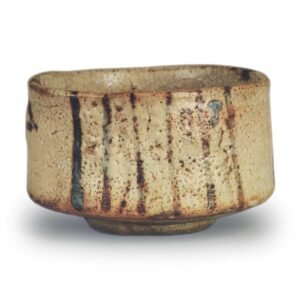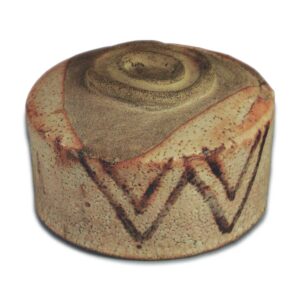

Height: 7.7-8.
Diameter: 12.2-12.4cm
Outer diameter of foot ring: 6.4cm
Height of foot ring: 0.7cm
This tea bowl is similar to the Sumiyoshi ware in that it has a double foot ring and a calendar design, but it is slightly larger than the Sumiyoshi ware and has a half-cylindrical shape with a simple, unforced appearance.
The overall shape and the design of the pattern are both extremely simple, so at first glance they seem to be too innocent and naive, but the low-slung shape is still something that has the dignity of antiquity. In the center of the base, which is made of soft clay, a double foot ring with the same sense of stability as the Sumiyoshi is clearly carved out, and from the waist to the mouth, it rises up while narrowing slightly, as with other works, but in this case, it is particularly linear, and the rim of the mouth is almost not curved. There are no signs of the use of a spatula on the body, and it seems to have been made on the potter’s wheel. There is no tea-dama in the middle, and the inside of the bowl is wide.
On one side of the body, a calendar pattern is drawn from the mouth to the waist, as in the Sumiyoshi, but this one has no shoulder design, and the triangular-shaped pattern is expressed with double lines. In addition, on the other side, slightly above the center of the body, there is a pattern of two triangles lined up together, reminiscent of a mountain range.
The name “Okuyama” is probably derived from the mountain-shaped pattern and the subdued reddish glaze, but the design is more cheerful and modern, and has a more carefree feel than “Okuyama”. The coloring of the iron painting is also as clear and vivid as the “Sumiyoshi”, and the gradation of the colors is also deep and rich.
The thick Shino glaze is not as white and soft as that of the Sumiyoshi, but on the other hand it has a sober and subdued color. As usual, the reddish color at the border between the glaze and the clay is clearly visible, and the rim and waist of the bowl are also very attractive.
The Shino glaze is applied more thickly over the calendar design on the body, and the demon plate appears to be oozing out, and the reddish color of the hearth also adds to the beauty of the scene. And while the surface of the Yamagata-style design is rather plain and modern, this surface has a more wabi-like flavor.
The glaze on the inside is quite rough and shows the thickness of the glaze.
There is one spot of gold repair on the rim.
On the lid of the box, the characters “Shino-yama” are written in gold and silver. The style of the characters is similar to that of Enshu, but the author is not sure.
The history of the box is also unclear, and it is only known that it was passed down in an old family in Gifu.



